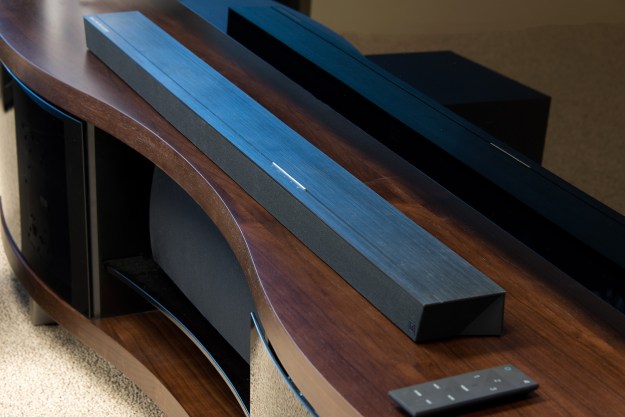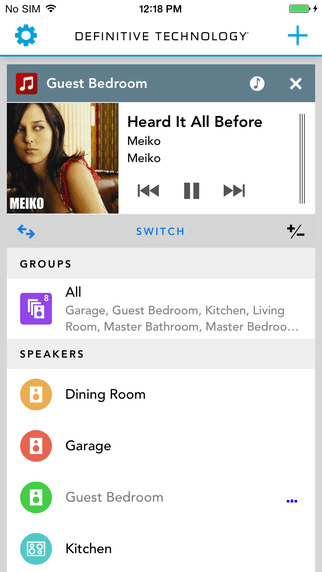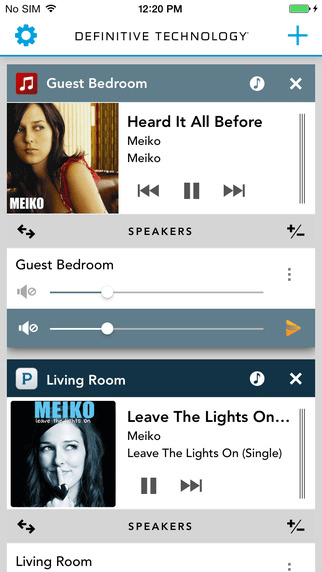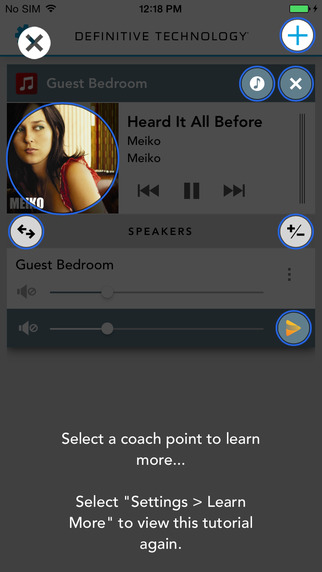
“You may have to squint to see Def Tech's impossibly small W Studio Micro, but you'll definitely hear it.”
- Warm and detailed midrange
- Clear, present dialog and upper register
- Rich musical bass
- Play-Fi multiroom technology
- Upper mids can sound a bit pinched
- Needs a better remote
Time and again, Definitive Technology has proven its prowess for packing serious power into packages both small and stylish. That includes excellent efforts like the Solo Cinema Studio sound bar, which matches sleek, minimalist styling with brawny, yet elegant performance.
The company’s latest effort, the 3.1-channel W Studio Micro, may just be its most ambitious piece yet in the mighty mouse set. Building on the success of the Solo Cinema and others in the Def Tech family, the Micro condenses the package into a silver-brushed bar that stands less than two inches tall. Packing DTS Play-Fi technology, the Micro can stand on its own as your audio centerpiece or be incorporated into a full-fledged multi-room sound system or surround system. While it isn’t without a few limitations, this system is proof positive you can get plenty of vigor and precision from a pint-sized bar.
Out of the box
Opening the W Studio Micro’s L-shaped box reveals a whole lot of foam and packaging, eventually giving way to a 44-inch beam surrounded by sharp-angled corners. The unit’s silver-brushed topside is made of rigid military-grade aluminum for less distortion as well as superior heat dissipation for the amplifiers. The finish is matched by a black fabric speaker screen that stretches across the front and sides, and a plastic back panel stocked with inputs. While there’s no HDMI connection, the bar does include dual optical inputs, a 3.5mm input, and even a subwoofer output. A small blue button at the left side initiates setup for Wi-Fi connection.
A small black box contains all the necessities for connection, including power cables, an optical digital cable, and a funky little rubberized remote with diamond angles along the top. And, of course, we can’t forget about the cubed subwoofer beneath it all, which boasts a down-firing driver on the bottom and little more than a power switch and power port at the back.
Features and design
While Def Tech’s new bar takes its name from the company’s flagship W Studio sound bar, that’s pretty much where the aesthetic similarities end. Unlike the blocky design of the original Studio, the Micro is wrought with hard angles and diagonal corners that make it look both refined and just a tad menacing. The machined aluminum topside is a nice stroke of elegance, but the real standout trait is, of course, the size: The Micro’s 1.75-inch height may not be the smallest we’ve seen, but it’s darned close, and the bar virtually disappears when set beneath today’s mammoth flat screens.
The Micros’ capable little sub can both rattle your cage and purr like a kitten.
While the height is truly “micro,” the bar does stretch back a smidge further than some of the slimmest sound bars in the segment, which is actually a relief considering the anemic sound of most bars this height. The three-inch depth allows just enough room for four oblong 1 x 3-inch drivers (tasked with building some warmth and punch in the midrange), matched by three 1-inch aluminum dome tweeters. The unit is powered by seven individual amps that pack a claimed 96 total watts.
The flat-paneled wireless subwoofer boasts an eight-inch down-firing driver cut in a similar design to the sub for the Solo Cinema we reviewed last year, which provided rich and thundering bass crafted with a pleasant blend of musicality. Though powered by just 50 watts of amplification — as opposed to 200 watts in the Solo Cinema — this new unit brings more of the same. But we’ll get into that below.
One bit of disappointment in the design comes from the angled remote, which is covered with the soft, rubbery coating that seems to cover the surface of so much tech these days. The controller is tiny and easy to lose like most sound bar remotes, but the real issue is the rubberized material that easily picks up oil stains from your fingers after just a few uses. That said, control is comprehensive, offering keys for power, volume, inputs, bass (i.e. sub volume), and even a center-channel volume control — a key feature that any listener who has trouble catching dialog will adore.
Luckily, the Studio Micro will follow commands from your TV remote (if it’s an Infrared remote, that is), though you’d never know it from the terse instruction booklet riding with the system. You won’t find it there, but we’ve listed the instructions in the “setup” section below.
The Micro may not be the smallest sound bar we’ve seen, but it’s darn close.
Thanks to Play-Fi, of course, a lot of the control of the bar may come from your smartphone, as the unit will sync up over Wi-Fi to playback music from your favorite streaming services (save Apple Music), and even storage drives via the Def Tech mobile app. You can also sync the system with multiple speakers throughout the home. And unlike most multi-room setups, Play-Fi is open source, meaning you can mix and match a smorgasbord of speakers from a growing list of manufacturers. If Sonos’ closed system is the Apple of multi-room wireless audio, think of Play-Fi as its Android competitor. And Def Tech is one of the top brands in the growing Play-Fi family.
Other features for the Micro include support for Dolby Digital 5.1, DTS HD, and SRS Trusurround decoding, as well as IR input/output for an optional IR repeater. And, at CES 2016, Def Tech announced that its Micro bar will soon be equipped with what the company is calling rear-streaming capabilities, allowing users to add two Play-Fi speakers to the system for true 5.1 wireless surround sound (though the speakers must be connected to a power source). That’s the power of Play-Fi at work.
Setup
Connecting the included cable to either of the Micro’s optical inputs is the best way to listen for TV, game console, or Blu-ray output. Setting up the Play-Fi connection is also a simple affair, with step-by-step instructions provided by the Definitive Technology app.
To program your TV remote: First, hold down the source key for around five seconds till you hear a tone. Then press and release the button on the bar that corresponds with the command you’d like to set, and do the same on the remote, which should cause another tone. Repeat for each command, and then hold the source button again for five seconds to exit “learning mode.” Unfortunately, this option is only for IR remotes — if you have a newer TV with Bluetooth remote connection, it may be time to invest in a universal remote.
Performance
You might assume that Def Tech’s decision to put its latest sound system (quite literally) into a very small box comes with some performance handcuffs — and you’d be right. But, despite some minor drawbacks from its miniature profile, the W Studio Micro brings the same brilliant sonic colors we’ve come to expect from Def Tech sound bars: open air up top, warmth and detail in the middle of the sound, and tight, musical bass below for impressive overall performance.
The primary goal for a large portion of sound bar shoppers is improvement in dialog performance — i.e. being able to understand a word on screen without cranking the volume. The Micro shines on like a crazy diamond there, lending a smooth and rich touch to dialog and a pleasant drop of sparkle at the attack that makes details really pop. The autonomous center channel is a key asset to dialog improvement, as well, allowing you to adjust the center to the subject matter, assuring every word comes through clear as vodka.
Those sonic talents alone would suffice for SportsCenter or your favorite sitcom, but the Micro doesn’t stop there, adding some bombastic thump to action scenes thanks to its brilliantly matched ambassador of bass. The little sub has plenty of power up its sleeves, pounding like a jackhammer when necessary, yet keeping bass rigid and musical. From booming explosions in space (which technically should be silent, we’ll add), to soothing string bass, this sub will rattle your cage and purr like a kitten, while still playing nicely with its sound bar buddy.
The Micro proves that going small doesn’t mean you have to sacrifice performance.
One limitation of the Micro’s size — we all have to abide by physics, after all — is a tight pinch in the upper mids that can give a flat, almost synthetic timbre to some instruments, especially brass. While the Micro’s penchant for extra buzz is a plus for the reedy textures of woodwinds, the bar leans a bit too far into the sputtering blatt of trombone and trumpet at times, making them sound a little toyish. Snare and even cymbals are also affected by the issue occasionally, which can put a slight damper on music playback.
That said, the Micro is definitely no slouch when tasked with tackling your music catalog — whether you want to chill out or rock hard. After the passing of alt-rock pioneer Scott Weiland, we put our DT STP playlist on 11 and the Micro never flinched. The little unit blasted the raucous mix with pure style, filling not just the room, but the entire level with bombastic sound. It was enough to make us worry the brushed aluminum cap might just blow right off. It didn’t, and the Micro proved that going small doesn’t mean you have to sacrifice power. Add in a polished, yet ruddy glow to acoustic guitars, clean and clear vocals, and plenty of detail throughout the sonic spectrum, and the Micro is more than up to the task of being your musical maestro.
Conclusion
With the new W Studio Micro, Def Tech has proven that small stature doesn’t have to mean small sound. This slim and stylish unit has little big man syndrome — in a good way — and it’s more than up to the task of livening up movies, gaming, and music playback for any room in the house. The inclusion of Play-Fi is a welcome addition as well, and those looking for an unobtrusive way to branch into multi-room sound will definitely want to consider the W Studio Micro as a primary building block.
Updated 1/4/2015: This post was updated to include Definitive Technology’s just-announced rear-streaming feature which allows for true 5.1 surround sound.
Highs
- Warm and detailed midrange
- Clear, present dialog and upper register
- Rich musical bass
- Play-Fi multiroom technology
Lows
- Upper mids can sound a bit pinched
- Needs a better remote










